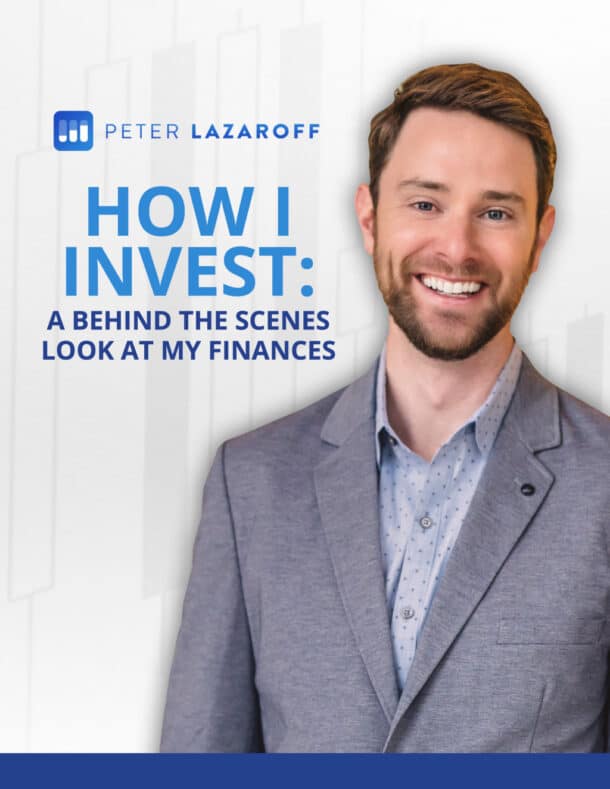Watch Now
Listen Now
I interviewed Brian Portnoy on the main stage of the CFA Institute’s global conference (CFA Live) for a fascinating deep dive into behavioral finance—moving beyond common biases to explore deeper insights into human decision-making, storytelling, and how these concepts can meaningfully enhance both investing and financial advising.
Brian began his financial career at Morningstar, eventually becoming deeply involved in hedge fund management and complex investments. His shift toward behavioral finance came after an insightful reading of The Art of Choosing by Sheena Iyengar. This sparked his journey into authoring three books on applied behavioral finance, including his influential The Geometry of Wealth. Today, Brian leads Shaping Wealth, a global platform delivering insights into behavioral finance, emotional intelligence, and positive psychology, aimed at enhancing the client-advisor experience.
Sign up for my newsletter so you can easily reply to my emails with your thoughts or questions for the podcast:
Navigating Today’s Investor Mindset: Uncertainty and Storytelling (05:28)
In an era defined by rapid change, today’s investors face unprecedented challenges marked by heightened volatility, deep uncertainty, complexity, and ambiguity—collectively known as a VUCA environment. Originally coined by the U.S. military in response to the geopolitical instability following the fall of the Berlin Wall, VUCA stands for Volatile, Uncertain, Complex, and Ambiguous. This framework captures precisely the state of today’s financial markets and broader economic climate, as investors grapple with a rapidly evolving landscape shaped by geopolitical tensions, technological disruptions such as artificial intelligence, and unpredictable market swings.
Brian Portnoy emphasizes that during such VUCA moments, human psychology instinctively seeks narratives, control, and community. Humans, Brian explains, are fundamentally pattern-seeking creatures wired to seek stability and understanding amid chaos. In uncertain times, people naturally gravitate toward storytelling to construct coherence out of complexity, searching for patterns that resonate with their past experiences or align with their expectations for the future.
The drive for control during VUCA periods is equally profound. Investors often feel compelled to regain a sense of agency in the face of unpredictability. This can lead to overly reactive investment decisions if not guided by careful counsel. Brian underscores the critical role financial advisors play in providing structured, reassuring narratives that help clients regain a sense of clarity and confidence.
Community and tribalism also play significant roles during these turbulent periods. Investors frequently look to peers, media, and influential figures for signals on how to respond. This reliance on social cues can amplify collective market behaviors—sometimes beneficial, but often exacerbating volatility. Advisors aware of these dynamics can better guide their clients away from herd-like responses, instead fostering rational and personalized financial strategies.
Brian’s insights underscore how understanding these inherent psychological responses to VUCA environments is crucial for advisors seeking to effectively communicate with clients. Embracing storytelling, facilitating meaningful conversations, and recognizing emotional drivers can significantly enhance the advisor-client relationship, providing investors with the confidence to weather uncertainty.
Beyond Behavioral Finance 1.0: Moving from Flaws to Flourishing (10:36)
Behavioral finance, originally established by Nobel laureates Daniel Kahneman and Amos Tversky, began with a clear mission: to identify and understand the cognitive biases that lead investors to deviate from purely rational economic decision-making. While foundational to the field, Brian Portnoy suggests this traditional approach—what he terms Behavioral Finance 1.0—focuses too narrowly on human flaws and cognitive errors, labeling these biases as irrational or even “stupid” behaviors. This, he argues, has unintentionally stigmatized normal human psychology.
In our conversation, Brian introduced a significant evolution in the field—Behavioral Finance 2.0. This approach expands beyond simply cataloging human errors to emphasizing a deeper, empathetic understanding of how humans actually think and behave. It integrates emotional intelligence, storytelling, and positive psychology, moving the conversation from merely pointing out what’s wrong with investor behavior to empowering clients to flourish financially and personally.
Behavioral Finance 2.0 recognizes that human beings are not purely rational calculators but inherently emotional storytellers. Brian stresses that understanding and leveraging storytelling is crucial for advisors, as clients connect more deeply to narratives than to raw data alone. This narrative-based approach helps clients better understand their own goals, values, and emotional triggers, leading to improved financial planning and decision-making.
Moreover, Brian advocates for shifting the dialogue from weaknesses to strengths, drawing from the science of positive psychology pioneered by researchers like Martin Seligman. Rather than viewing human biases solely as obstacles, advisors are encouraged to recognize clients’ inherent strengths—such as resilience, adaptability, and capacity for growth. This strength-based approach not only enhances client relationships but also promotes long-term financial and personal well-being.
Ultimately, Behavioral Finance 2.0 positions financial advising as a holistic practice, aimed not just at wealth accumulation but at facilitating meaningful and contented lives. This pivot toward human flourishing represents a powerful shift, redefining what it means to be an effective financial advisor in today’s complex financial landscape.
The Power of Asking Better Questions in Financial Advising (17:49)
In the rapidly evolving world of financial advising, the quality of an advisor’s questions often determines the depth and success of client relationships. Brian Portnoy emphasizes that questions should be approached not as interrogations, but as invitations—tools to open meaningful dialogue, foster understanding, and ultimately enhance trust.
Brian suggests that good questioning begins by establishing genuine empathy. Advisors can create an open atmosphere by starting with simple yet powerful questions such as:
- “How are you feeling about your financial situation right now?”
- “What concerns you most about your financial future?”
One of Brian’s most recommended approaches is the simple, yet profound phrase: “Tell me more.” This open-ended prompt invites clients to delve deeper into their initial responses, uncovering underlying emotions or concerns that might not surface with more direct questioning. Brian emphasizes that this approach signals genuine interest and active listening, strengthening the advisor-client relationship.
Another impactful technique Brian highlights is encouraging clients to reflect on their future selves. Advisors can ask clients:
- “What will you want to remember about this decision five years from now?”
- “Imagine your life in retirement—what are the most important things you hope to achieve?”
These future-oriented questions help clients step away from immediate anxieties, creating a broader perspective and reinforcing their long-term objectives.
Brian also stresses the effectiveness of questions that challenge immediate action, such as:
- “What if we did nothing in response to this market event?”
- “If we don’t make this change now, what is the worst outcome you foresee?”
By asking these thought-provoking questions, advisors encourage clients to critically evaluate their impulse reactions and consider the benefits of thoughtful inaction, often resulting in more measured and beneficial decisions.
Ultimately, Brian’s insights on asking better questions underline their critical role in elevating financial advising from transactional interactions to deeply meaningful conversations, significantly enhancing client trust, satisfaction, and long-term financial success.
Using the LASER Protocol for Client Conversations During Volatility (26:50)
Brian Portnoy introduced a structured communication strategy known as the LASER Protocol (Listen, Assess, Scaffold, Educate, Revisit), specifically designed to guide financial advisors through sensitive conversations during periods of significant market volatility.
Listen
The first step involves genuine, active listening. Advisors create a safe environment by allowing clients to fully express their fears, concerns, and uncertainties without immediate interruption or judgment. This foundational step builds trust and demonstrates empathy, making clients feel truly heard. Brian stresses the importance of resisting the urge to immediately offer solutions or explanations, instead giving clients space to share their emotions and experiences fully.
Assess
Once clients have articulated their concerns, advisors assess the underlying emotions and motivations driving these feelings. Brian suggests asking thoughtful, empathetic questions such as:
- “Can you help me understand why this particular situation makes you feel anxious?”
- “What worries you most when you think about your investments right now?”
- “How have past experiences influenced how you feel about the current volatility?”
This careful assessment helps pinpoint specific emotional and cognitive triggers behind the client’s anxiety.
Scaffold
The scaffold step involves guiding clients gently toward exploring their options without prematurely dictating solutions. Here, advisors help clients see the broader picture, potentially reframing their concerns in a constructive context. Advisors might suggest hypothetical scenarios or encourage clients to consider alternative perspectives by asking questions like:
- “If we think about your long-term plan, how might this short-term volatility impact your overall goals?”
- “What are some ways we could manage your concerns without making immediate changes?”
This approach helps clients recognize that they have multiple options, fostering a sense of control and agency even amid uncertainty.
Educate
With a supportive emotional foundation in place, advisors can effectively educate clients about relevant market conditions, investment principles, and historical contexts. Brian emphasizes that education at this stage is not about overwhelming clients with data but providing targeted, clear, and reassuring information. Effective communication might include highlighting historical examples of market recovery, clarifying the nature of market volatility, and reinforcing core principles of disciplined investing.
Revisit
Finally, the revisit stage ensures that client plans remain relevant and aligned with their personal values and goals. This step involves revisiting the financial plan or investment strategy, evaluating whether the current market volatility genuinely necessitates adjustments, or whether the existing strategy remains robust. Regularly revisiting the plan reinforces its value, demonstrating adaptability and resilience, and reminding clients of their original rationale for their investment approach.
Through the LASER Protocol, advisors can skillfully manage client anxiety during turbulent times, enhancing trust, clarity, and confidence in financial planning decisions.
Practical Applications: Storytelling in Financial Advice (40:30)
In a profession long dominated by spreadsheets, Monte Carlo simulations, and performance metrics, storytelling might seem like a soft skill. But as Brian Portnoy argues, it’s fast becoming one of the most essential tools in an advisor’s repertoire.
Humans are natural storytellers. We use stories to make sense of our world, to process change, to create identity. And in financial advising, where decisions often intersect with deeply personal fears, hopes, and goals, stories provide context and clarity in ways that raw numbers cannot. According to Brian, every investor is living a story—and the advisor’s role is to understand that narrative, then help shape its next chapters.
Effective storytelling in a financial context doesn’t require grandiose anecdotes. Sometimes, it’s as simple as an analogy. A well-timed comparison—like likening diversification to a balanced diet, or describing volatility as turbulence on a flight that doesn’t change the destination—can anchor abstract investment concepts in tangible, memorable terms.
Brian distinguishes between “storytelling” and “storyselling.” While many in the financial industry use narratives as persuasive tools to sell a product or service, true storytelling is about empathy. It’s about listening first, understanding the client’s lived experience, and then framing advice within the narrative of their life. This requires a blend of emotional intelligence and conversational skill rarely emphasized in traditional financial education.
Storytelling also helps advisors understand not just what clients want to do, but who they want to become. This identity-driven approach leads to more meaningful conversations around goals and priorities. A client saving for retirement, for example, isn’t merely concerned with a number—they’re envisioning a future lifestyle, relationships, routines, and contributions. Good advisors help bring that vision into sharper focus through narrative.
In a world where AI can generate financial plans and algorithms can allocate assets, storytelling is an enduring human edge. It’s how advisors connect, guide, and ultimately help clients live out the stories they most want to tell.
How Behavioral Insights Improve Investment Decisions (45:57)
Behavioral finance has often been framed as a catalog of cognitive errors—a useful warning system for what not to do. But Brian Portnoy argues that this narrow view misses the deeper value of behavioral insights: helping investors and advisors design better processes that embrace, rather than attempt to erase, human nature.
Portnoy introduces a key concept from his book The Geometry of Wealth—the idea of “funded contentment.” Instead of maximizing returns for their own sake, the goal is to fund a meaningful, well-lived life. That means financial decisions should be grounded not just in statistical optimization, but in psychological satisfaction and personal priorities.
This reframing of success changes how we think about investment decisions. It places emphasis on process over prediction, values consistency over cleverness, and encourages humility in the face of market uncertainty. Behavioral finance, when applied correctly, helps investors build resilient systems—routines and rules—that reduce the need for reactive decision-making during times of stress.
Portnoy notes that biases can’t be eliminated, but they can be managed through awareness and structure. For example, rather than trusting one’s gut in volatile markets, he encourages advisors to create pre-committed playbooks with clients. These include documentation of why decisions are made, under what conditions they should be revisited, and what indicators might justify a change in course. It’s a strategy rooted in behavioral science, but executed through discipline.
Moreover, understanding behavioral tendencies like loss aversion or confirmation bias allows advisors to tailor communication. If a client is particularly sensitive to downside risk, presenting performance data through the lens of goal progress rather than benchmark comparisons may foster greater peace of mind and engagement.
Ultimately, behavioral insights do more than help investors avoid mistakes—they provide a framework for aligning money with meaning. And in a world where complexity often breeds paralysis, clarity through behaviorally informed planning is one of the most valuable advantages any investor can have.
Resources:
- The Geometry of Wealth by Brian Portnoy
- Shaping Wealth (Brian’s Firm)
- EP 122: Connecting With Your Future Self to Make Better Decisions ft. Hal Hershfield
- CFA Institute
- The Art of Choosing by Sheena Iyengar
The Long Term Investor audio is edited by the team at The Podcast Consultant
Submit Your Question For the Podcast
Do you have a financial or investing question you want answered? Submit your question through the “Ask Me Anything” form at the bottom of my podcast page.
Support the Show
Thank you for being a listener to The Long Term Investor Podcast. If you’d like to help spread the word and help other listeners find the show, please click here to leave a review.
I read every single one and appreciate you taking the time to let me know what you think.
Free Financial Assessment
Do you want to make smart decisions with your money? Discover your biggest opportunities in just a few questions with my Financial Wellness Assessment.

Disclosure: This content, which contains security-related opinions and/or information, is provided for informational purposes only and should not be relied upon in any manner as professional advice, or an endorsement of any practices, products or services. There can be no guarantees or assurances that the views expressed here will be applicable for any particular facts or circumstances, and should not be relied upon in any manner. You should consult your own advisers as to legal, business, tax, and other related matters concerning any investment.
The commentary in this “post” (including any related blog, podcasts, videos, and social media) reflects the personal opinions, viewpoints, and analyses of the Plancorp LLC employees providing such comments, and should not be regarded the views of Plancorp LLC. or its respective affiliates or as a description of advisory services provided by Plancorp LLC or performance returns of any Plancorp LLC client.
References to any securities or digital assets, or performance data, are for illustrative purposes only and do not constitute an investment recommendation or offer to provide investment advisory services. Charts and graphs provided within are for informational purposes solely and should not be relied upon when making any investment decision. Past performance is not indicative of future results. The content speaks only as of the date indicated. Any projections, estimates, forecasts, targets, prospects, and/or opinions expressed in these materials are subject to change without notice and may differ or be contrary to opinions expressed by others.
Please see disclosures here.
















